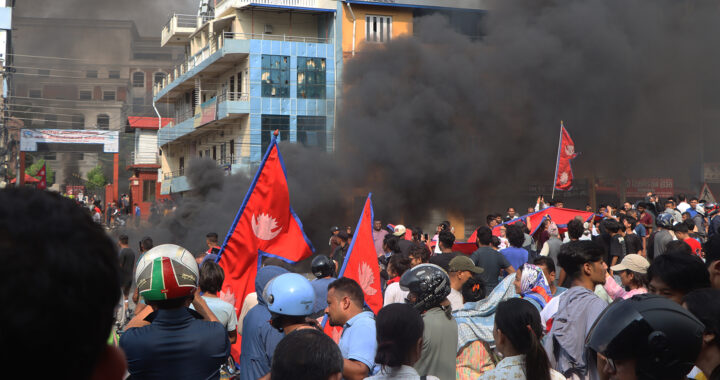A series of large-scale demonstrations erupted in Nepal after 4 September 2025. The movement, predominantly organized by Generation Z students and other young members of the Nepalese population, began following a nationwide ban on many popular social media platforms, but had expanded to encompass broader issues of governance, transparency, and political accountability. The protests quickly escalated into violence against public officials and vandalism of government buildings across the country.
From Social Media Ban to Pervasive Corruption: The Causes of the 2025 Nepalese Gen Z Protests
Nationwide Social Media Ban as Catalyst
The immediate spark for the protests was the decision of the Nepalese government to block popular social media platforms on 4 September 2025. These include Facebook, X, YouTube, Reddit, Signal, and LinkedIn. Officials explained that the decision stemmed from the failures of these platforms to register under new national regulations.
However, for the young Nepalese population, the digital blackout felt like a direct assault on their lifeline. Social media has become not only a space for entertainment but also for economic opportunity, networking, and political discourse. The abrupt removal of this medium convinced many that the government sought to silence younger voices.
Social media is popular in Nepal. Data from Global Digital Insights and Gurkha Technology show that the country has 14.3 million active social media users. This is equivalent to about 48.1 percent of the population. Nevertheless, under a 2023 directive, the Nepalese government introduced a registration requirement for social media platforms.
Frustration with Nepotism and Inequality
The banning of social media in Nepal coincided with ongoing online discourse about the children of political elites who publicize their extravagant lifestyles online. These flaunters have been dubbed “Nepo Kids” because their luxurious cars, expensive international trips, and foreign education contrast with the stagnant economic situation facing ordinary citizens.
Public anger has been brewing due to a series of digital exposures. Note that the average income in Nepal is only about USD 1400 per year, and youth unemployment hovers above 20 percent. Seeing privileged families flaunt their wealth while many struggled daily created an explosive sense of injustice that erupted once the social media ban provided a trigger.
Pervasive Corruption and Governance Failures
Longstanding grievances over corruption and poor governance have also been in place. Issues like the controversial Airbus procurement deal in 2017 lingered as reminders of unaccountable leaders enriching themselves. The people of Nepal had long complained of bureaucratic inefficiency, favoritism, and institutions more loyal to elites than to citizens.
Nevertheless, for the Generation Z population, corruption is not a distant political concern but a daily obstacle to opportunity. Young people see their futures constrained by leaders prioritizing personal networks rather than the public good. The protests have become an outlet for amassed dissatisfaction with a system perceived as unjust and ineffective.
The Nepal Living Standards Survey 2022-2023 reported that 20.27 percent of the population lived below the poverty line. This equated to around 5.9 million Nepalese. Nepal also scored 34 out of 100 in the 2024 Corruption Perception Index of Transparency International. This core ranked the country 100th among the 180 countries included in the index.
Inspiration from Regional Youth Movements
The incident was not isolated. Developments in neighboring countries influenced the actions of Nepalese youths. In 2024, Bangladesh witnessed historic youth protests that toppled entrenched leaders, while Sri Lanka experienced similar mobilizations in preceding years. These movements demonstrated how collective youth action could force real political change.
Young protesters in Nepal drew courage and strategy from these examples. Digital activism and online vigilance, creative forms of expression, and decentralized organization all echoed patterns observed in neighboring countries. The lesson was clear for young Nepalis. Their generation is capable of transforming politics through widespread nationwide protests.
Resignation, Casualties, and Deaths: The Immediate Aftermath of the 2025 Nepalese Gen Z Protests
The protests resulted in the resignation of Prime Minister K. P. Sharma Oli after mounting pressure made his position untenable. His departure marked a dramatic political shift because it underscored the ability of youth movements to destabilize established leadership. It also revealed the deep crisis of legitimacy facing the political elite of Nepal.
Moreover, beyond changes in government leadership, the protests forced the government to reverse its controversial social media ban. The swift reinstatement of digital platforms highlighted the influence of collective mobilization. This development symbolized not only restored online freedoms but also a rare instance of accountability achieved through public action.
The demonstrations, however, left visible scars across Nepalese institutions and infrastructure. Fires consumed government buildings, flights were diverted as airports closed, and the military occupied major sites to maintain order. Jhala Nath Khanal, the wife of former Prime Minister Jhala Nath Khanal, died after protesters set their house on fire.
FURTHER READINGS AND REFERENCES
- Scarr, C., Fraser, S., and Ethirajan, A. 9 September 2025. “Nepal Parliament Set on Fire After PM Resigns Over Anti-Corruption Protests.” BBC. Available online
- Sharma, G. and Chitrakar, N. 10 September 2025. “Young Anti-Corruption Protesters Oust Nepal PM Oli.” Reuters. Available online
- Jha, N. 9 September 2025. “How Discord Became Control Room for Nepal’s Gen Z Protests.” India Today. Available online
- KC, A. 30 June 2025. “The Digital Landscape of Nepal: An Extensive Analysis of Internet and Social Media User Trends.” Gurkha Technology. Available online
- 12 February 2024. “NLSS-IV Puts 20.27% Population of Nepal Below Poverty Line.” Nepalkhabar. Available online
- The Himalayan. 8 September 2025. “Gen Z Youths Stage Protest at Maitighar Against Corruption, Social Media Ban.” The Himalayan. Available online
- Transparency International. 2024. “Nepal.” Corruption Perception Index. Transparency International. Available online
Photo Credit: Himal Subedi / 2025 Nepalese Gen Z Protesters In Front of Bharatpur Mahanagarpalika Office / 2025 / Adapted/ CC BY-SA 4.0
